基于BP神经网络对MNIST数据集检测识别
1.作者介绍
王凯,男,西安工程大学电子信息学院,2022级研究生
研究方向:机器视觉与人工智能
电子邮件:[email protected]
张思怡,女,西安工程大学电子信息学院,2022级研究生,张宏伟人工智能课题组
研究方向:机器视觉与人工智能
电子邮件:[email protected]
2.BP神经网络介绍
2.1 BP神经网络
搭建一个两层(两个权重矩阵,一个隐藏层)的神经网络,其中输入节点和输出节点的个数是确定的,分别为 784 和 10。而隐藏层节点的个数还未确定,并没有明确要求隐藏层的节点个数,所以在这里取50个。现在神经网络的结构已经确定了,再看一下里面是怎么样的,这里画出了对一个数据的运算过程:
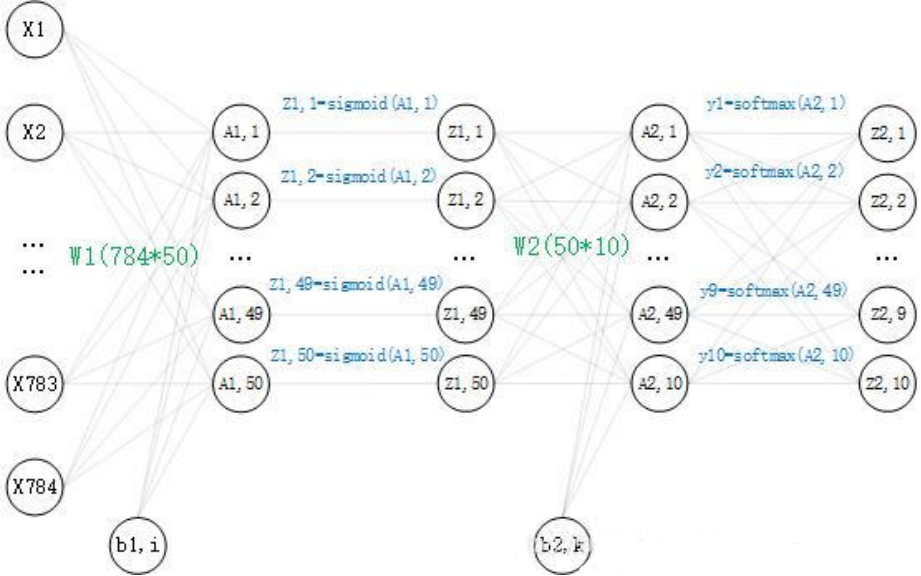
数学公式:
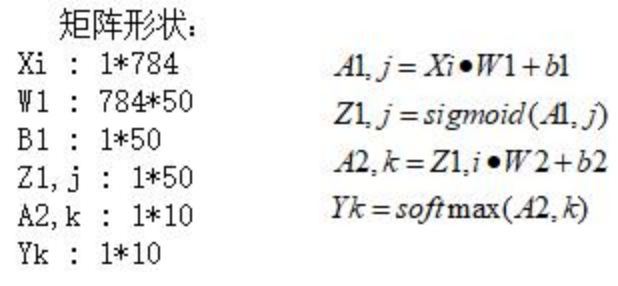
3.BP神经网络对MNIST数据集检测实验
3.1 读取数据集
安装numpy :pip install numpy
安装matplotlib pip install matplotlib
mnist是一个包含各种手写数字图片的数据集:其中有60000个训练数据和10000个测试时局,即60000个 train_img 和与之对应的 train_label,10000个 test_img 和 与之对应的test_label。

其中的 train_img 和 test_img 就是这种图片的形式,train_img 是为了训练神经网络算法的训练数据,test_img 是为了测试神经网络算法的测试数据,每一张图片为2828,将图片转换为2828=784个像素点,每个像素点的值为0到255,像素点值的大小代表灰度,从而构成一个1784的矩阵,作为神经网络的输入,而神经网络的输出形式为110的矩阵,个:eg:[0.01,0.01,0.01,0.04,0.8,0.01,0.1,0.01,0.01,0.01],矩阵里的数字代表神经网络预测值的概率,比如0.8代表第五个数的预测值概率。
其中 train_label 和 test_label 是 对应训练数据和测试数据的标签,可以理解为一个1*10的矩阵,用one-hot-vectors(只有正确解表示为1)表示,one_hot_label为True的情况下,标签作为one-hot数组返回,one-hot数组 例:[0,0,0,0,1,0,0,0,0,0],即矩阵里的数字1代表第五个数为True,也就是这个标签代表数字5。
数据集的读取:
load_mnist(normalize=True, flatten=True, one_hot_label=False):中,
normalize : 是否将图像的像素值正规化为0.0~1.0(将像素值正规化有利于提高精度)。flatten : 是否将图像展开为一维数组。 one_hot_label:是否采用one-hot表示。
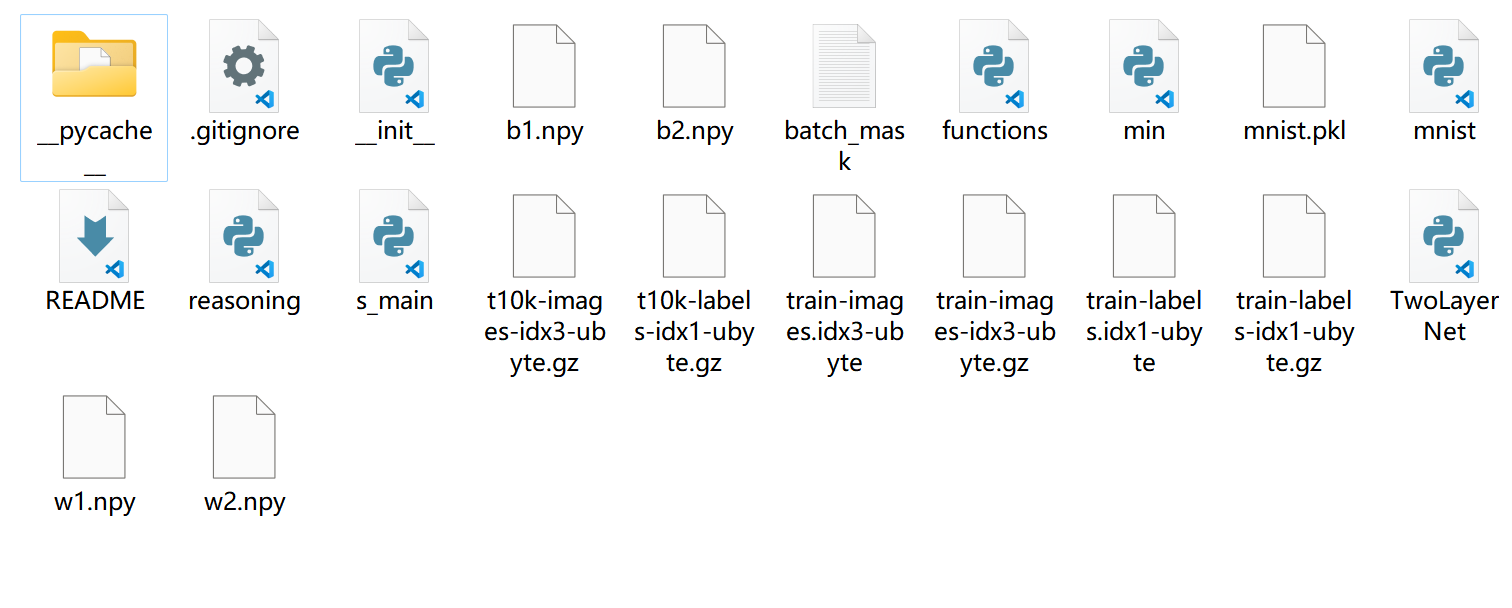
完整代码及数据集下载:https://gitee.com/wang-kai-ya/bp.git
3.2 前向传播
前向传播时,我们可以构造一个函数,输入数据,输出预测。
def predict(self, x):
w1, w2 = self.dict['w1'], self.dict['w2']
b1, b2 = self.dict['b1'], self.dict['b2']
a1 = np.dot(x, w1) + b1
z1 = sigmoid(a1)
a2 = np.dot(z1, w2) + b2
y = softmax(a2)
3.3 损失函数
求出神经网络对一组数据的预测值,是一个1*10的矩阵。
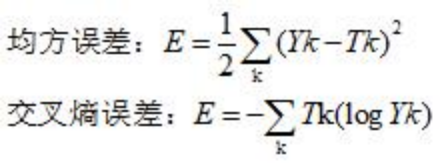
其中,Yk表示的是第k个节点的预测值,Tk表示标签中第k个节点的one-hot值,举前面的eg:(手写数字5的图片预测值和5的标签)
Yk=[0.01,0.01,0.01,0.04,0.8,0.01,0.1,0.01,0.01,0.01]
Tk=[0, 0, 0, 0, 1, 0, 0, 0, 0, 0]
值得一提的是,在交叉熵误差函数中,Tk的值只有一个1,其余为0,所以对于这个数据的交叉熵误差就为 E = -1(log0.8)。
在这里选用交叉熵误差作为损失函数,代码实现如下:
def loss(self, y, t):
t = t.argmax(axis=1)
num = y.shape[0]
s = y[np.arange(num), t]
return -np.sum(np.log(s)) / num
3.4 构建神经网络
前面我们定义了预测值predict, 损失函数loss, 识别精度accuracy, 梯度grad,下面构建一个神经网络的类,把这些方法添加到神经网络的类中:
for i in range(epoch):
batch_mask = np.random.choice(train_size, batch_size) # 从0到60000 随机选100个数
x_batch = x_train[batch_mask]
y_batch = net.predict(x_batch)
t_batch = t_train[batch_mask]
grad = net.gradient(x_batch, t_batch)
for key in ('w1', 'b1', 'w2', 'b2'):
net.dict[key] -= lr * grad[key]
loss = net.loss(y_batch, t_batch)
train_loss_list.append(loss)
# 每批数据记录一次精度和当前的损失值
if i % iter_per_epoch == 0:
train_acc = net.accuracy(x_train, t_train)
test_acc = net.accuracy(x_test, t_test)
train_acc_list.append(train_acc)
test_acc_list.append(test_acc)
print(
'第' + str(i/600) + '次迭代''train_acc, test_acc, loss :| ' + str(train_acc) + ", " + str(test_acc) + ',' + str(
loss))
3.5 训练
import numpy as np
import matplotlib.pyplot as plt
from TwoLayerNet import TwoLayerNet
from mnist import load_mnist
(x_train, t_train), (x_test, t_test) = load_mnist(normalize=True, one_hot_label=True)
net = TwoLayerNet(input_size=784, hidden_size=50, output_size=10, weight_init_std=0.01)
epoch = 20400
batch_size = 100
lr = 0.1
train_size = x_train.shape[0] # 60000
iter_per_epoch = max(train_size / batch_size, 1) # 600
train_loss_list = []
train_acc_list = []
test_acc_list = []
保存权重:
np.save('w1.npy', net.dict['w1'])
np.save('b1.npy', net.dict['b1'])
np.save('w2.npy', net.dict['w2'])
np.save('b2.npy', net.dict['b2'])
结果可视化:
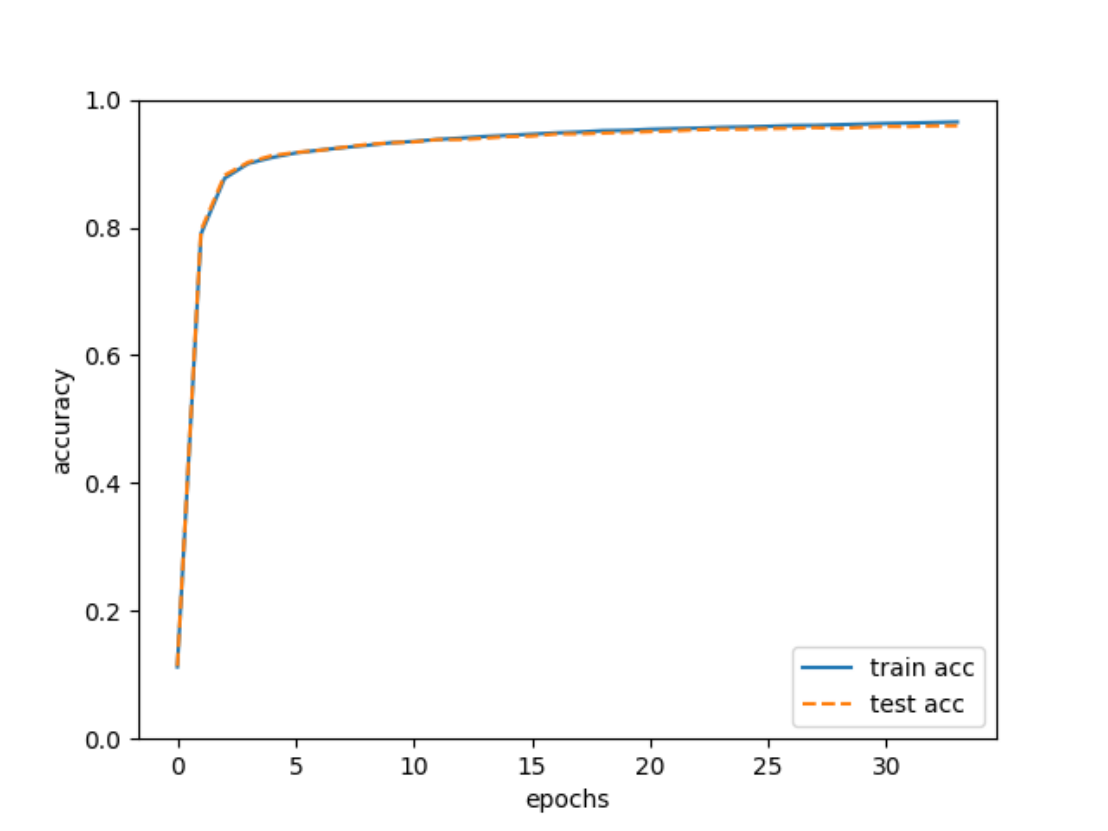
3.6 模型推理
import numpy as np
from mnist import load_mnist
from functions import sigmoid, softmax
import cv2
######################################数据的预处理
(x_train, t_train), (x_test, t_test) = load_mnist(normalize=True, one_hot_label=True)
batch_mask = np.random.choice(100,1) # 从0到60000 随机选100个数
#print(batch_mask)
x_batch = x_train[batch_mask]
#####################################转成图片
arr = x_batch.reshape(28,28)
cv2.imshow('wk',arr)
key = cv2.waitKey(10000)
#np.savetxt('batch_mask.txt',arr)
#print(x_batch)
#train_size = x_batch.shape[0]
#print(train_size)
########################################进入模型预测
w1 = np.load('w1.npy')
b1 = np.load('b1.npy')
w2 = np.load('w2.npy')
b2 = np.load('b2.npy')
a1 = np.dot(x_batch,w1) + b1
z1 = sigmoid(a1)
a2 = np.dot(z1,w2) + b2
y = softmax(a2)
p = np.argmax(y, axis=1)
print(p)
运行python reasoning.py
可以看到模型拥有较高的准确率。
4.完整代码
训练
import numpy as np
import matplotlib.pyplot as plt
from TwoLayerNet import TwoLayerNet
from mnist import load_mnist
(x_train, t_train), (x_test, t_test) = load_mnist(normalize=True, one_hot_label=True)
net = TwoLayerNet(input_size=784, hidden_size=50, output_size=10, weight_init_std=0.01)
epoch = 20400
batch_size = 100
lr = 0.1
train_size = x_train.shape[0] # 60000
iter_per_epoch = max(train_size / batch_size, 1) # 600
train_loss_list = []
train_acc_list = []
test_acc_list = []
for i in range(epoch):
batch_mask = np.random.choice(train_size, batch_size) # 从0到60000 随机选100个数
x_batch = x_train[batch_mask]
y_batch = net.predict(x_batch)
t_batch = t_train[batch_mask]
grad = net.gradient(x_batch, t_batch)
for key in ('w1', 'b1', 'w2', 'b2'):
net.dict[key] -= lr * grad[key]
loss = net.loss(y_batch, t_batch)
train_loss_list.append(loss)
# 每批数据记录一次精度和当前的损失值
if i % iter_per_epoch == 0:
train_acc = net.accuracy(x_train, t_train)
test_acc = net.accuracy(x_test, t_test)
train_acc_list.append(train_acc)
test_acc_list.append(test_acc)
print(
'第' + str(i/600) + '次迭代''train_acc, test_acc, loss :| ' + str(train_acc) + ", " + str(test_acc) + ',' + str(
loss))
np.save('w1.npy', net.dict['w1'])
np.save('b1.npy', net.dict['b1'])
np.save('w2.npy', net.dict['w2'])
np.save('b2.npy', net.dict['b2'])
markers = {'train': 'o', 'test': 's'}
x = np.arange(len(train_acc_list))
plt.plot(x, train_acc_list, label='train acc')
plt.plot(x, test_acc_list, label='test acc', linestyle='--')
plt.xlabel("epochs")
plt.ylabel("accuracy")
plt.ylim(0, 1.0)
plt.legend(loc='lower right')
plt.show()
测试
import numpy as np
from mnist import load_mnist
from functions import sigmoid, softmax
import cv2
######################################数据的预处理
(x_train, t_train), (x_test, t_test) = load_mnist(normalize=True, one_hot_label=True)
batch_mask = np.random.choice(100,1) # 从0到60000 随机选100个数
#print(batch_mask)
x_batch = x_train[batch_mask]
#####################################转成图片
arr = x_batch.reshape(28,28)
cv2.imshow('wk',arr)
key = cv2.waitKey(10000)
#np.savetxt('batch_mask.txt',arr)
#print(x_batch)
#train_size = x_batch.shape[0]
#print(train_size)
########################################进入模型预测
w1 = np.load('w1.npy')
b1 = np.load('b1.npy')
w2 = np.load('w2.npy')
b2 = np.load('b2.npy')
a1 = np.dot(x_batch,w1) + b1
z1 = sigmoid(a1)
a2 = np.dot(z1,w2) + b2
y = softmax(a2)
p = np.argmax(y, axis=1)
print(p)